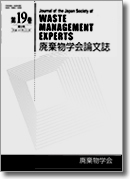Volume 15, Issue 6
Displaying 1-10 of 10 articles from this issue
- |<
- <
- 1
- >
- >|
Paper
-
2004Volume 15Issue 6 Pages 443-455
Published: November 30, 2004
Released on J-STAGE: May 31, 2010
Download PDF (5008K) -
2004Volume 15Issue 6 Pages 456-464
Published: November 30, 2004
Released on J-STAGE: May 31, 2010
Download PDF (7803K) -
2004Volume 15Issue 6 Pages 465-471
Published: November 30, 2004
Released on J-STAGE: May 31, 2010
Download PDF (6626K) -
2004Volume 15Issue 6 Pages 472-479
Published: November 30, 2004
Released on J-STAGE: May 31, 2010
Download PDF (4599K) -
2004Volume 15Issue 6 Pages 480-490
Published: November 30, 2004
Released on J-STAGE: May 31, 2010
Download PDF (4324K) -
2004Volume 15Issue 6 Pages 491-499
Published: November 30, 2004
Released on J-STAGE: May 31, 2010
Download PDF (2684K) -
2004Volume 15Issue 6 Pages 500-510
Published: November 30, 2004
Released on J-STAGE: May 31, 2010
Download PDF (6165K) -
2004Volume 15Issue 6 Pages 511-520
Published: November 30, 2004
Released on J-STAGE: May 31, 2010
Download PDF (1134K)
Note
-
2004Volume 15Issue 6 Pages 521-524
Published: November 30, 2004
Released on J-STAGE: May 31, 2010
Download PDF (3830K) -
2004Volume 15Issue 6 Pages 525-528
Published: November 30, 2004
Released on J-STAGE: May 31, 2010
Download PDF (434K)
- |<
- <
- 1
- >
- >|
